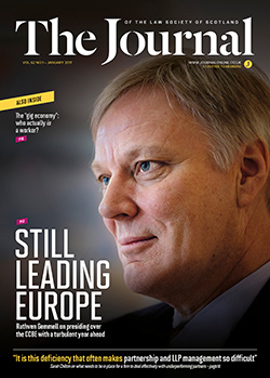"One-shot" rule sees rejection income soar

Rejection income at Registers of Scotland (RoS) has soared since the “one-shot” rule was introduced with the 2014 land registration reforms, a freedom of information request has revealed.
Oban solicitor Andrew Vennard asked RoS to state the income generated from land registration rejection penalties for the financial years from 2012-13 to 2015-16.
RoS’s response read as follows:
“The below table includes rejection fees which take place prior to an application being taken on (pre-intake rejections) and rejection fees for applications which make it past intake but are subsequently not accepted for registration in line with the Land Registration etc (Scotland) Act 2012 (post-intake rejections). The latter was known as cancellations under the previous legislation.”
| LAND REGISTER REJECTION INCOME | |||||
| 2012-13 | 2013-14 | 2014-15 | 2015-16 | ||
| Pre-intake | £169,380 | £199,080 | £233,100 | £597,360 | |
| Post-intake | £9,960 | £236,700 | |||
| £169,380 | £199,080 | £243,060 | £834,060 | ||
The figures show the effect of the “one-shot” rule, introduced under the 2012 Act, which took effect from 8 December 2014. Under this rule, applications for registration that are defective through failing to meet certain conditions set out in the Act must be rejected, rather than being temporarily set aside as under the previous system. Rejection fees were waived for the first two months of the new regime but have been applied since February 2015, near the end of the 2014-15 year.
Mr Vennard commented: “Like most conveyancing solicitors, I find it cause for concern that there has been such a huge increase in penalties, and that there is also an increasingly adversarial relationship between solicitors and RoS. The penalties are justified on the grounds that they help to cover costs, though in RoS’s accounts for the year ending 31 March 2016, they reported a surplus of £7.6 million, and so contrary to what RoS often state, the penalties are not necessary to cover the costs of rejection, as there would still be a substantial surplus without them.”
Registers’ comment
Asked by the Journal for RoS’s observations on the figures, a spokesperson said: “Rejected applications are expensive and inconvenient for both solicitors and RoS, and it is important to note, in the first instance, that this service costs RoS significantly more than it brings in through fees.
“We continue to consult with our customers, as well as the Law Society of Scotland’s Property Law Committee, to understand properly why mistakes are made and how they can be avoided, though the majority of rejections are for basic omissions and administrative oversights (such as failing to sign the application form).
“A number of measures have already taken place to assist solicitors with the application process. Throughout 2016, RoS has run a number of first-registration workshops for practitioners and these covered the different requirements for various types of property. A section that focused on avoiding rejections was also included.
“RoS have also developed and created a new knowledge base microsite (www.ros.gov.uk/about-us/ros-blog/2016/our-guidance-just-got-beta), providing a new home for registration guidance and additional support content (getting started guides, tutorials, hints and tips, etc). The site is currently in beta, but the basic underlying principle is that content is task-based, accessible and searchable, based on user testing and input from end users.
“Furthermore, our current consultation covering digital transformation sets out proposals for some consequential changes and other improvements to the land registration application form to support digital submission. The aim is to streamline the experience for the user, whilst minimising the scope for an application to be rejected.
“The use of a digital form, allied to a digital deed prepared and submitted through a secure digital channel, will enable us to provide the applicant with increased confidence at the point of submission that the application meets the conditions of registration, while ultimately the drafting of dispositions would remain a matter for the solicitor.
“The quoted figures also need to be understood in context. The £243,060 figure covers a period where the 1979 Act was in force and the overall volume of rejections was lower because the Keeper permitted applications to be placed in standover while they were augmented by the submitting solicitor.”
“The 2012 Act introduced the one-shot rule because the Scottish Law Commission and the Scottish Parliament decided the standover process was inefficient and a waste of public money. The effect is that applications with errors or omissions which would have entered standover under the 1979 Act now require to be rejected. Finally, the £243,060 figure is also impacted by the period, shortly after commencement of the 2012 Act, where no rejection fee was payable.”
In this issue
- Private prosecution: the Glasgow Rape Case revisited
- The commercialisation of space
- Feminism: all is not what it seems…
- Retaking the narrative on complaints
- Reading for pleasure
- Opinion: Alan McIntosh
- Book reviews
- Profile
- President's column
- RoS riding to the four (hundred)
- People on the move
- Scot in the European hot seat
- When partners fall short
- Uber: a great gig?
- Brexit: the end of cross-border practice?
- Closing in: the gender pay gap rules
- Simple procedure – it's complicated
- When changing the defender is OK
- Solemn procedure: beware the changes
- Divorce and the new state pension
- Delivery of alcohol: a “game changer”?
- A tale of two "Budgets"
- Scottish Solicitors' Discipline Tribunal
- "One-shot" rule sees rejection income soar
- Law without frontiers
- CJEU decision supports LPP protections
- Society thank-you for STARTS support
- From the Brussels Office
- Law reform roundup
- Expertise plus: promoting a sector strength
- Paralegal pointers
- What to do about client interest?
- Still free to market?
- New year, new contact
- Ask Ash
- Paying homage to King Cash






